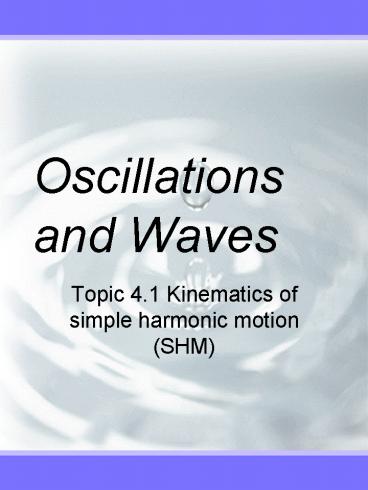Oscillations and Waves - PowerPoint PPT Presentation
1 / 18
Title:
Oscillations and Waves
Description:
Oscillations and Waves Topic 4.1 Kinematics of simple harmonic motion (SHM) Examples of oscillations A periodic motion is one during which a body continually retraces ... – PowerPoint PPT presentation
Number of Views:252
Avg rating:3.0/5.0
Title: Oscillations and Waves
1
Oscillations and Waves
- Topic 4.1 Kinematics of simple harmonic motion
(SHM)
2
Examples of oscillations
- A periodic motion is one during which a body
continually retraces its path at equal intervals
Nature of oscillating system p.e. stored as k.e. possessed by moving
Mass on helical spring Elastic energy of spring Mass
cantilever Elastic energy of bent rod Rod
Simple pendulum Gravitational p.e. of bob Bob
Vertical rod floating in liquid of zero viscosity Gravitational p.e. of rod or liquid rod
3
Amplitude
- Its position x as a function of time t is where
A is the amplitude of motion the distance from
the centre of motion to either extreme - T is the period of motion the time for one
complete cycle of the motion - Its position x as a function of time t
O
B
A
4
Amplitude
- Which ball has a larger amplitude?
Ball A
- Which ball has the larger period?
Ball A
5
Frequency
- The frequency of motion, f, is the rate of
repetition of the motion -- the number of cycles
per unit time. There is a simple relation between
frequency and period
- If ball B has a time period of 12 s, what is
the frequency?
f 0.0833 Hz
6
Angular frequency
- Angular frequency is the rotational analogy to
frequency. Represented as , and is the rate of
change of an angle when something is moving in a
circular orbit. This is the usual frequency
(measured in cycles per second), converted to
radians per second. That is
- Which ball has the larger angular frequency?
Ball B
7
- Displayed below is a position-time graph of a
piston moving in and out.
Find the
Amplitude Period Frequency Angular frequency
10 cm
0.2 s
5.0 Hz
10p rads-1
8
Phase
- Here is an oscillating ball.
- Its motion can be described as follows
- Then it moves with v lt 0 through the centre to
the left - Then it is at v 0 at the left
- Then it moves with v gt 0 through the centre to
the right - Then it repeats...
9
Phase
This information concentrates on what phase of
the cycle is being executed. It is not concerned
with the particulars of amplitude.
Mathematically, the phase is the "w t" in
x(t) A cos (w t)
10
Phase
- Here is an oscillating ball.
Recall x(t) A cos (w t)
What phase is the ball in when x 0, v lt 0
A. 0.00 p rad B. 0.25 p rad C. 0.50 p rad D.
1.0 p rad E. 1.5 p rad F. 1.7 p rad
11
Phase
- Here is an oscillating ball.
Recall x(t) A cos (w t)
What phase is the ball in when x A, v 0
A. 0.00 p rad B. 0.25 p rad C. 0.50 p rad D.
1.0 p rad E. 1.5 p rad F. 1.7 p rad
12
SHM and circular motion
Uniform Circular Motion (radius A, angular
velocity w) Simple Harmonic Motion (amplitude
A, angular frequency w)
- Simple harmonic motion can be visualized as
the projection of uniform circular motion onto
one axis - The phase angle wt in SHM corresponds to the
real angle wt through which the ball has moved in
circular motion.
13
Velocity and acceleration
- Once you know the position of the oscillator for
all times, you can work out the velocity and
acceleration functions.
x(t) A cos (wt f)
- The velocity is the time derivative of the
position so
v(t) -A w sin (wt f)
- The Change from cos to sin means that the
velocity is 90o out of phase with the
displacement when when x 0 the velocity is a
maximum and when x is a minimum v 0
- The acceleration is the time derivative of the
velocity so
a(t) -A w2 cos (wt f)
- Notice also from the preceding that
- a(t) -w2x
- The acceleration is exactly out of phase with
the displacement.
14
Velocity and acceleration
- Watch the oscillating duck. Let's consider
velocity now - Remember that velocity is a vector, and so has
both negative and positive values.
- Where does the magnitude of v(t) have a
maximum value?
C
- Where does v(t) 0?
A and E
15
Velocity and acceleration
- Watch the oscillating duck. Let's consider
acceleration now - Remember that acceleration is a vector, and so
has both negative and positive values.
- Where does the magnitude of a(t) have a
maximum value?
A and E
- Where does a(t) 0?
C
16
Summary 1
- You now know several parameters that are used to
describe SHM - amplitude (A)
- period (T)
- frequency (f)
- angular frequency (w)
- initial phase (f)
- maximum velocity (v(t)max) and
- maximum acceleration (a(t)max)
17
Summary 2
- There are many relations among these parameters.
One minimum set of parameters to completely
specify the motion is - amplitude (A)
- angular frequency (w)
- initial phase (f)
- You are already familiar with this set, which is
used in - x(t) A cos (wt f)
- The trick in solving SHM problems is to take the
given information, and use it to extract A, w and
f. Once you have A, w and f, you can calculate
anything.
18
Summary 3
- For a given body with SHM and with the
displacement x is given by
In terms of time In terms of displacement
Velocity
Acceleration































